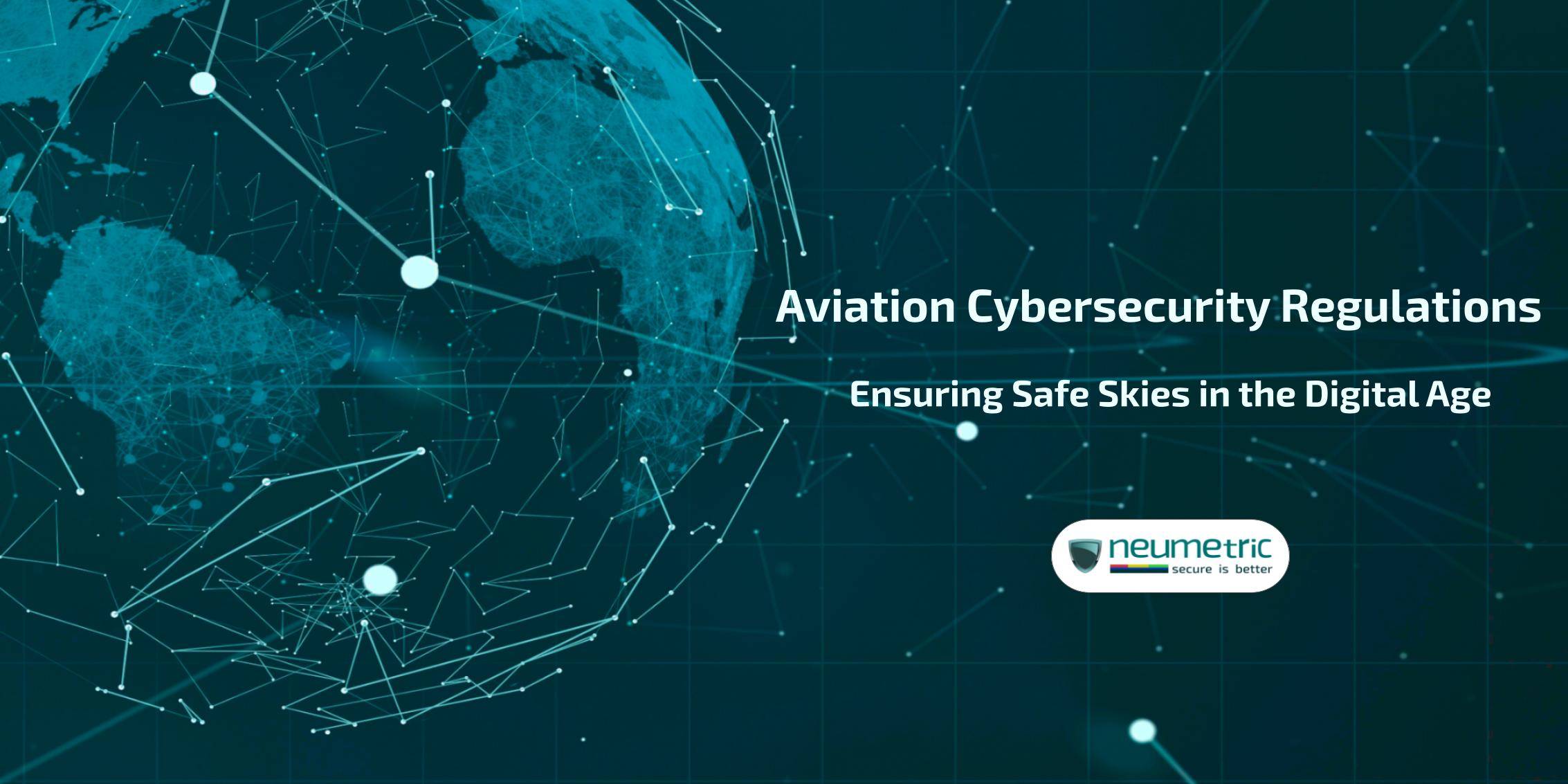Table of Contents
ToggleIntroduction
The aviation industry has undergone a remarkable transformation in the digital age. From the dawn of aviation to the modern era, technological advancements have revolutionised the way aircraft operate, communicate, and navigate. The integration of digital systems, automation, and connectivity has brought unprecedented efficiency and convenience but has also introduced new vulnerabilities.
Cybersecurity stands as a cornerstone in guaranteeing the safety and reliability of modern air travel. As aircraft and air traffic control systems have become increasingly interconnected and reliant on digital technologies, the need to protect these systems from cyber threats has grown exponentially. Ensuring robust cybersecurity measures is paramount to safeguarding passengers, crew, and critical aviation infrastructure from potential cyber attacks that could compromise safety and operational integrity.
Understanding Aviation Cybersecurity
The interconnected nature of aviation systems makes them susceptible to a wide array of vulnerabilities. Aircraft systems, comprising crucial components such as flight control systems, navigation systems, and communication networks, rely heavily on digital interfaces. These digital dependencies expose them to potential cyber threats, encompassing unauthorised access, malware infiltration, and manipulations that could compromise the safety and operations of flights.
- Types of Cloud Services (IaaS, PaaS, SaaS):
Cloud services consist of Infrastructure as a Service (IaaS), Platform as a Service (PaaS), and Software as a Service (SaaS). IaaS offers virtualized computing resources including servers, storage, and networking. PaaS provides a platform for developers to create, deploy, and manage applications without concerning themselves with underlying infrastructure. SaaS delivers software applications over the internet, enabling users to access them from various devices without the need for installation.
- Cyber Threats Faced by Aircraft Systems
Aircraft systems confront various threats like unauthorised access, malware, and system manipulation. These threats have the potential to compromise critical flight operations and jeopardise safety measures, highlighting the significance of stringent cybersecurity measures within aviation infrastructure.
- Vulnerabilities in Air Traffic Control Systems
Air traffic control systems are equally vulnerable to cyber attacks that could disrupt communications, compromise flight data integrity, or interfere with air traffic management, emphasising the critical need to secure these systems against potential cyber threats.
The Role of Regulations in Aviation Cybersecurity
The evolution of cybersecurity regulations in aviation is a response to the progressive digitalization of aircraft and airspace infrastructure. Over time, authorities have acknowledged the necessity for tailored measures to effectively address the emerging cybersecurity risks within aviation domains.
- International Standards (e.g., ICAO)
Organisations like the International Civil Aviation Organization (ICAO) have laid down comprehensive guidelines and standards to standardise cybersecurity practices globally, aiming to create a unified and robust cybersecurity framework across international aviation networks.
- National Aviation Authorities’ Regulations (e.g., FAA, EASA)
National aviation authorities, such as the Federal Aviation Administration (FAA) in the United States and the European Union Aviation Safety Agency (EASA), have developed specific regulations to ensure cybersecurity compliance within their respective jurisdictions, ensuring a secure aviation environment.
Achieving compliance with these regulations poses challenges due to the complex nature of aviation systems, varying international standards, and the rapid pace of technological advancements.
Assessing Cybersecurity Risks in Aviation
- Cyber–Physical Risks
The intricate blend of digital and physical aspects within aviation systems creates vulnerable points where cyber attacks can lead to tangible physical consequences, potentially compromising aircraft control or safety systems. The interconnection of these elements exposes critical vulnerabilities that, if exploited, could have severe implications for the safety and integrity of flights.
- Data Security Concerns
Ensuring the protection of sensitive flight data, passenger information, and communication channels from unauthorised access or manipulation is of paramount importance. Safeguarding these aspects prevents potential breaches that could compromise operational integrity or put passenger data at risk.
- Impact and Consequences
Past cyber attacks have highlighted the immense impact they can have on aviation, spanning from significant flight disruptions to substantial financial losses and, more critically, compromised safety measures. Understanding these consequences underscores the urgency for robust cybersecurity measures within the aviation sector.
- Lessons Learned
Examining and dissecting previous cyber incidents are invaluable in identifying vulnerabilities and implementing proactive strategies to mitigate future risks. These lessons serve as guiding principles for the continuous improvement of cybersecurity measures in aviation.
Technological Advancements in Aviation Cybersecurity
- Encryption Technologies
Implementing robust encryption methodologies serves as a crucial line of defence in securing data transmissions and preventing unauthorised access to critical aviation systems. Strong encryption protocols are fundamental in safeguarding sensitive information from potential cyber threats.
- Intrusion Detection and Prevention Systems
Sophisticated intrusion detection systems that operate in real-time are pivotal in monitoring and promptly responding to potential cyber threats. These advanced systems significantly enhance the resilience of aviation infrastructure by swiftly identifying and neutralising threats as they arise.
Collaboration and Best Practices
- Public-Private Partnerships in Strengthening Aviation Cybersecurity
Collaboration among governmental bodies, aviation authorities, industry stakeholders, and cybersecurity experts is indispensable. This collaboration fosters the exchange of knowledge, resources, and best practices essential for establishing a robust defence against cyber threats within the aviation sector.
- Sharing Threat Intelligence and Best Practices
Establishing platforms for sharing threat intelligence and successful cybersecurity strategies facilitates a collective defence mechanism against continuously evolving threats. This shared knowledge strengthens the overall cybersecurity posture and response capabilities within the aviation industry.
- Training and Education Initiatives
Investment in comprehensive training programs and educational initiatives is crucial in cultivating a skilled workforce capable of effectively implementing and maintaining robust cybersecurity measures. Empowering personnel with relevant skills ensures a proactive approach to mitigating cybersecurity risks.
Challenges and Future Outlook
- Emerging Threats: AI, IoT, and Next-Gen Aviation
The emergence of artificial intelligence (AI), the Internet of Things (IoT), and next-generation aviation technologies introduces a new landscape of challenges and vulnerabilities. Addressing these requires proactive measures and innovative cybersecurity strategies to stay ahead of potential threats.
- Balancing Security with Innovation
Maintaining a delicate balance between fostering innovation and implementing stringent cybersecurity measures remains a significant challenge for the aviation industry. Navigating this balance is critical to ensure technological advancements don’t compromise cybersecurity standards.
- Regulatory Adaptations for Future Needs
Adapting regulations to keep pace with technological advancements and emerging threats is vital for maintaining a robust cybersecurity framework within the aviation sector. Continuous regulatory adaptations are necessary to address evolving challenges and ensure the efficacy of cybersecurity measures.
Conclusion
The landscape of aviation cybersecurity is intricate and multifaceted, demanding comprehensive strategies and proactive measures to ensure the safety and reliability of air travel in the digital age. Assessing cybersecurity risks within aviation illuminates the vulnerabilities stemming from the convergence of digital and physical elements, emphasising the critical need to safeguard sensitive data and systems from potential breaches. Reflecting on past incidents underscores the significant impact of cyber attacks on aviation, reinforcing the urgency for robust cybersecurity measures and continuous improvement through lessons learned.
Technological advancements play a pivotal role in fortifying aviation cybersecurity. Encryption technologies and sophisticated intrusion detection systems stand as critical defences against unauthorised access and cyber threats. Furthermore, collaboration among stakeholders, including public-private partnerships and knowledge-sharing initiatives, bolsters the collective defence mechanism against evolving threats. Investing in training programs and educational initiatives ensures a skilled workforce capable of implementing and maintaining effective cybersecurity measures within the aviation sector.
FAQs:
Why is cybersecurity in aviation so important, and how does it impact the safety of air travel?
Cybersecurity in aviation is crucial because it safeguards critical systems and data from potential cyber threats that could compromise the safety and reliability of air travel. With the integration of digital technologies in aircraft and air traffic control systems, cyber attacks pose a significant risk. Ensuring robust cybersecurity measures helps prevent unauthorised access, manipulation of sensitive data, and potential disruptions to flight operations, thus preserving the safety and integrity of air travel.
What role do technological advancements play in enhancing aviation cybersecurity?
Technological advancements serve as fundamental pillars in fortifying aviation cybersecurity. Encryption technologies are pivotal in securing data transmissions and preventing unauthorised access to critical aviation systems. Sophisticated intrusion detection systems continuously monitor and respond to potential cyber threats in real-time, bolstering the resilience of aviation infrastructure. These innovations are integral in safeguarding against evolving cyber threats and maintaining the integrity of aviation systems.
How are collaboration and education contributing to improving cybersecurity in aviation?
Collaboration among stakeholders, including governments, aviation authorities, industry experts, and cybersecurity professionals, is essential. Public-private partnerships facilitate the exchange of knowledge, resources, and best practices, strengthening the collective defence against cyber threats. Moreover, investing in training programs and educational initiatives ensures a skilled workforce capable of implementing and maintaining robust cybersecurity measures within the aviation sector. These collaborative efforts and educational initiatives are key in enhancing the overall cybersecurity posture of the aviation industry.





